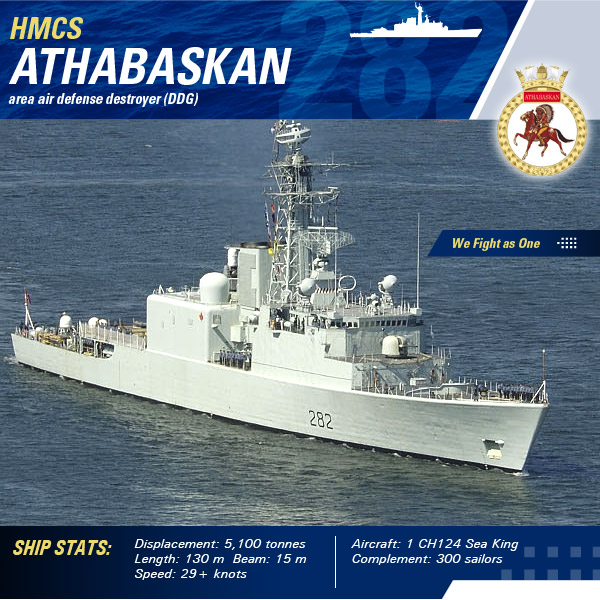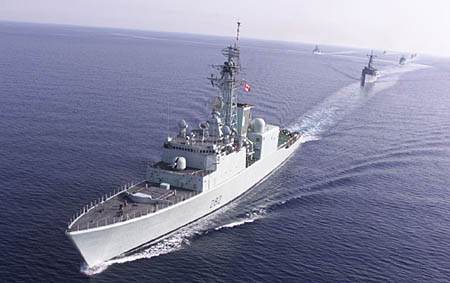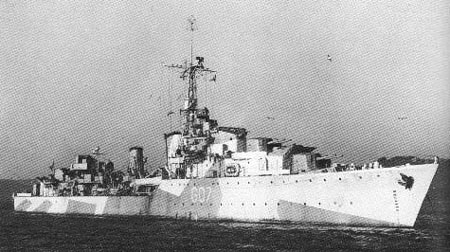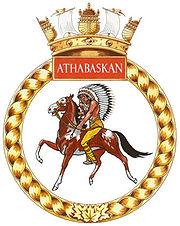HMCS Athabaskan


Built at Davie Shipbuilding Ltd. In Lauzon, Quebec, HMCS ATHABASKAN, the third warship of her class, was launched on November 27th, 1970 and commissioned on September 30th, 1972.
Her primary weapons were anti-submarine which included mortars, homing torpedoes and two CH-124 SEA KING helicopters armed with torpedoes. The SEA KING is an all-weather aircraft, which can operate at speeds of up to 150 knots. For defense against air and surface threats, HMCS ATHABASKAN originally had the Canadian Sea Sparrow missile system and a 5" 54 caliber gun. Both these systems were radar controlled.
August 24th, 1990, forty years after her predecessor sailed for Korea, ATHABASKAN accompanied by the destroyer TERRA NOVA and the supply ship PROTECTEUR, sailed for the Persian Gulf to support a multi-national naval blockade following the Iraqi invasion of Kuwait. There, as the flagship of Canada's naval Task Group, she enforced UN sanctions and later participated in Operation Desert Storm, the campaign to liberate Kuwait.
In April 1991, ATHABASKAN returned to Halifax to commence her TRUMP conversion, which prepared her for modern day warfare.
Ships Characteristics
HMCS Athabaskan is the third ship of the Tribal class helicopter destroyer to complete the Tribal Update and Modernization Program (TRUMP) conversion. Among the most modern warships afloat, she is capable of many roles in support of Canada's sovereignty and collective defence agreements. Incorporated in HMCS Athabaskan are a gas turbine propulsion plant, computerized Command and Control System, new weapons and improved communication and detection equipment.
Athabaskan was built by Davies Shipbuilding Ltd. in Lauzon, Quebec. She was launched on November 27th, 1970 and commissioned on November 30th, 1972. On August 24th, 1990, Athabaskan accompanied by Terra Nova and Protecteur sailed for the Persian Gulf to participate in the Gulf War. In April 1991, she returned to Halifax to commence her TRUMP conversion which prepared her for modern day warfare.
With the completion of the TRUMP conversion, the ship now had an advanced anti-sumarine, area air defence, and command and control capabilities.
The area air defence capability was realized with the installation of the vertically launched, "Standard" surface-to air missile system. Installation of a Oto Melara 76mm super rapid gun mount and a Phalanx 20mm Close-in-Weapon System (CIWS) round out the offensive and defensive capabilities of the ship.
Crew:
314 Officers and non-commisioned members.
Displacement:
5120 tons.
Dimensions:
129.9m x 15.7m x 6.9m (426' x 50' x 22.3')
Propulsion:
Two Pratt & Whitney FT4A2 gas turbines - 50,000 shp; two Allison 570KF gas turbines - 12,000 shp; two shafts with five bladed controllable pitched propeller.
Speed:
27+ Knots
Endurance:
4500NM at 20 knots.
Missiles:
29 medium range Anti-Air missile (SM2-MR).
Cannon:
One 76mm Super Rapid Gun Mount (OTO Melara).
CIWS:
One 20mm Close-in weapon system (Vulcan Phalanx).
Torpedoes:
Two triple tubes firing MK46 anti-submarine torpedoes.
Helicopters:
Two CH124 A/B Sea King.
The First Athabaskan
In February, 1944, HMC Ships Athabaskan, Huron, and Haida joined the 10th Destroyer Flotilla based at Plymouth, England. During an offensive sweep in the English Channel early on the morning of April 29th, Athabaskan and Haida encountered enemy destroyers of the German Elbing class. Repeated hits were scored and one of the enemy destroyers was driven aground. During the course of the action Athabaskan was torpedoed in the early hours of the morning, caught fire and descended to her final resting place. The Commanding Officer, LCDR John Stubbs, together with ten officers and 100 men were lost; five officers and eighty men were subsequently taken prisoner, and one officer and forty-five men were rescued by Haida and returned to England. The Captain had actually made his way to the Haida safely, but swam out into the seas a second time, to search for more survivors.
G07 recieved Battle honors for her bravery and achievements in the Arctic 1943-1944, and her fight in the English Channel during 1944.
ATHABASKAN G07
Ordered 05/04/1940
Laid Down 31/10/1940
Launched 15/11/1941
Comissioned 03/02/1941
Fate Sunk
29/04/1944

The first Athabaskan was launched on November 15, 1941 and commissioned in 1943. Late in August, 1943, while senior ship of a group operating in the Bay of Biscay, Athabaskan was damaged by a German aerial glider bomb dropped from one of several aircraft which attacked simultaneously.
The bomb struck the Port Side aft of the bridge, passed through the Chart House and Petty Officer's Mess and exited out through the Starboard side, exploding as it exited the hull. The entire Starboard side of the ship from the bow to the break of the foc'sle was destroyed. Both of the ships guns were rendered unserviceable, leaving the vessel unable to defend itself. Eighteen men were severely injured in the attack, five would be buried at sea on the transit home. The remaining sailors reacted quickly, using anything in their vicinity to shore the gaping hole in the ship. Thanks to these men, Athabaskan returned to port under her own steam with only one boiler room and two fuel tanks flooded.
The Second Athabaskan
For the next ten months she operated in support of UN forces, mainly in a Naval Gunfire Support role.On the 2nd of August, 1951, following a short docking and leave period in Esquimalt, B.C., she left home for a second tour in Korea. After serving with distinction in the Korean War, Athabaskan continued to exercise and operate from Esquimalt until 1959 when she was transferred to Halifax.
On March 1st, 1964, she gained public attention when she went to the aid of the Liberian tanker Amphialos that had broken in two during a storm. In a rescue operation which required daring and a high standard of seamanship, 34 of a crew of 36 were rescued.Athabaskan was placed in reserve in January, 1965 and eventually sold on June 27th, 1969.
All who sailed in Athabaskan can look back with pride and affection on a happy and efficient ship. The ships company of the third Athabaskan is dedicated to sustaining this reputation

Within three weeks of sinking, another Athabaskan was laid down in Halifax. She was christened on May 4th, 1946 and commissioned on January 20th, 1948. On July 5th, 1950, in company with HMCS Cayuga and HMCS Sioux, she sailed to join the United Nations forces fighting to contain the Communist invasion of South Korea. Within 20 hours of arriving in Sasebo, Japan, Athabaskan sailed on her first patrol.

Ship's Crest
Blazon: On a field of argent a North American Indian clad in buckskin leggings and beaded moccasins but bare to the waist except for a necklace of bear claws and ear ornaments. The Indian wears the full feathered headdress and is mounted bare back upon an indian pony being halted from the trot. The Indian holds a red bow and arrow in the ready position, the latter pointing down.The badge design is based on the one which had been planned by Officers of the original ATHABASKAN, but was not completed before their ship was lost in action.
Ships Colours: White and Scarlet
Motto: We fight as One
Battle Honours:
* Arctic: 1943-1944
* English Channel: 1944
* Korea: 1950-1953
* Persian Gulf: 1991